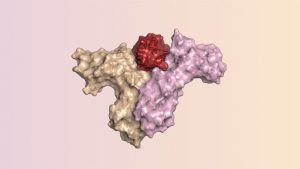Robert F. Service in Science:
 For patients with aggressive kidney and skin cancers, an immune-boosting protein called interleukin-2 (IL-2) can be a lifesaver. But the dose at which it fights cancer can also produce life-threatening side effects. Now, scientists have used computer modeling to design a new protein from scratch that mimics IL-2’s immune-enhancing abilities, while avoiding its dangerous side effects. The protein has so far been tested only in animals, but it may soon enter human trials. IL-2 plays a key role in directing the body’s immune response to outside invaders. The protein, a signaling molecule called a cytokine, ramps up the activity of white blood cells known as T lymphocytes by binding simultaneously to their IL-2β and IL-2γ receptors. In cells where a third type of receptor, IL-2α, is present, IL-2 binds collectively to all three. In other white blood cells, this dampens the body’s immune response. But it can also occur in cells in blood vessels, causing those vessels to leak, a potentially deadly condition.
For patients with aggressive kidney and skin cancers, an immune-boosting protein called interleukin-2 (IL-2) can be a lifesaver. But the dose at which it fights cancer can also produce life-threatening side effects. Now, scientists have used computer modeling to design a new protein from scratch that mimics IL-2’s immune-enhancing abilities, while avoiding its dangerous side effects. The protein has so far been tested only in animals, but it may soon enter human trials. IL-2 plays a key role in directing the body’s immune response to outside invaders. The protein, a signaling molecule called a cytokine, ramps up the activity of white blood cells known as T lymphocytes by binding simultaneously to their IL-2β and IL-2γ receptors. In cells where a third type of receptor, IL-2α, is present, IL-2 binds collectively to all three. In other white blood cells, this dampens the body’s immune response. But it can also occur in cells in blood vessels, causing those vessels to leak, a potentially deadly condition.
“People have tried for 30 years to alter IL-2 to make it safer and more effective,” says Daniel Adriano Silva Manzano, a biochemist at the University of Washington (UW) in Seattle and first author of the new study. But IL-2 is unstable and stops working when it loses its normal 3D shape, and many mutations destabilize the structure further, Silva Manzano says.
To do better, Silva Manzano teamed up with lab director David Baker, a protein designer at UW, and colleagues in the United States, Portugal, Spain, and the United Kingdom, to remake IL-2 from scratch. They started by studying atomic maps of IL-2 interacting with the desirable β and γ receptors, as well as the undesirable α receptor. IL-2 is a single long chain of amino acids. When it folds up into its active 3D shape, it forms four segments that twist into spirals called alpha helixes that are held together by a series of loops that tie them together in a bundle. At the bottom of this bundle of helixes are two sites that bind to the β and γ receptors. Meanwhile, portions of one of the helixes and two loops at the top of the protein bind to α receptors. Baker, Silva, and their colleagues programmed protein-design software Baker had developed, called Rosetta, to maintain the needed interactions with the β and γ receptors but eliminate the portion that binds to α receptors. Rosetta produced 40 options. After analyzing them, the team synthesized and tested 22, tweaking the best to improve the designer protein’s stability and its effectiveness at binding the desired receptors. Finally, the researchers settled on a version they dubbed Neo-2/15, which shares only 14% of its amino acid sequence with IL-2. Lab studies revealed it bound tightly to β and γ receptors, but not to α receptors. In mouse models of colon cancer and melanoma, the compound reduced side effects associated with α receptors, strongly inhibited tumor growth, and even eliminated tumors in a handful of animals. Regular IL-2 given to other mice didn’t do the latter, they report today in Nature.
More here.
